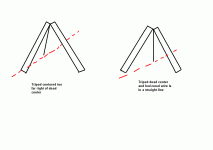jinman
Rest in Peace
- Joined
- Feb 23, 2001
- Messages
- 21,008
- Location
- Texas - Wise County - Sunset
- Tractor
- NHTC45D, NH LB75B, Ford Jubilee
I have one property line that goes through gullys, over a hill, and through some woods. Both corners are marked with stakes. I placed white markers on each stake and had a buddy fly me over. I was planning on taking photos of my whole place, but during the flight we made a pass around the property and I got one great photo showing both corners. After having the photo, I put a straight line between the two points and looked at trees and identifying features. My neighbor had somebody walk the line and lay it out with a GPS. We were both within a foot of each other. We weren't building a fence, so this was all just for fun, but we were surprised to be so close.
I'm wondering if Google Earth might have enough resolution in your area to do something similar. I don't think I'd build a fence by it, but it would be fun just for comparison's sake.
In the overall scheme of things, when you compare the cost of a good fence and the labor you'll do building it, a surveyor's fee is "chicken feed." I'd hire the surveyor and count his fee as money well spent.
I'm wondering if Google Earth might have enough resolution in your area to do something similar. I don't think I'd build a fence by it, but it would be fun just for comparison's sake.
In the overall scheme of things, when you compare the cost of a good fence and the labor you'll do building it, a surveyor's fee is "chicken feed." I'd hire the surveyor and count his fee as money well spent.
